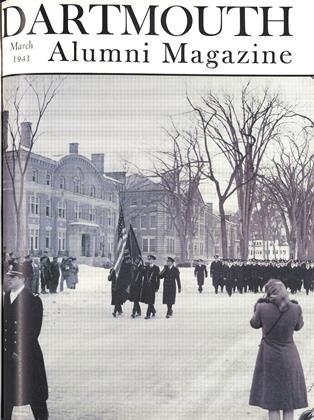FROM TIME TO TIME the editors willprint brief thumbnail sketches aboutDartmouth men who have made out-standing records in this war. The firstsketches are of Lt. Rob Roy Carruthers '42,of Larchmont, New York who left collegebefore graduation to enlist in the Army AirForce, and Capt. William B. Stevenson, ofthe U.S.M.C.-U. F. W.
LIEUT. CARRUTHERS was a member of the 1 19 th Bomber Group which has made itself very famous in this war. It is the only group which has seen continuous daily fighting since Pearl Harbor; has been cited four times by the War Department for exceptional service, an all time record; almost every man has been decorated, most of them several times, and two-thirds of the personnel have either been killed or wounded or are missing. Lt. Carruthers has been decorated three times: Distinguished Flying Cross, Oak Leaf Cluster for second award of same, and Silver Star for conspicuous gallantry.
Rob Carruthers was navigator of the plane which took General Mac Arthur, his son, wife, chief of staff and some other of fleers from Mindinao to Central Australia. Four days after this trip he returned as navigator for President Quezon's removal. No enemy was sighted and during these flights the constant danger of tropical cyclones, capable of removing a wing of a plane, was luckily missed. Then Carruthers returned to his real mission of bombing New Guinea. Once as navigator of the "fortress" on a photographic mission at Milne Bay and Faisi Harbor his plane was attacked by three fighters. During the fortyfive minute engagement, Lt. Carruthers manned the forward gun and helped repel about twenty attacks, scoring several hits on the Jap planes. Throughout the engagement he continued to give the pilot courses to cloud formations which helped the plane escape. For this exploit Lt. Carruthers received the Silver Star.
Lt. Carruthers is now in this country.
WILLIAM D. STEVENSON '39, from Titusville, Penn., is a communications officer in the First Marine Raider Battalion. Since college days Capt. Stevenson has been in the Marine Reserve Corps and he was called to active service early in 1941, and was with the unit that made the original landing in the Tulagi-Guadalcanal area on August 7, 1942. After three and a half months in that region his outfit was relieved. (For an account of this action read Richard Tregaskis' recent Guadalcanal Diary.)
Captain Stevenson was presented with the Navy Cross, the Navy's highest honor except for the Congressional Medal of Honor, which is given "for extraordinary heroism in action against the enemy."
"He daringly led a reconnaissance patrol," the citation said, "toward enemy lines on the battalion's left flank, despite rifle and machine gun fire. Later he remained at his communications post after other command post personnel had been displaced, continuing contact with Marine forces until the wires were cut from the rear by the infiltrating enemy."
Capt. Stevenson in reporting to his parents about his award said: "Five of my men were decorated, one Navy Cross and four Silver Stars for gallantry in action against the enemy. Admiral Halsey certainly impressed me He gave us a fine, short fightin' talk While I feel greatly honored, it is sad to think the real heroes were not here to get their medals."
There are other crosses at Guadalcanal.
WIN DECORATIONS FOR GALLANTRY IN ACTION Captain William D. Stevenson '39, left, roho won the Navy Cross last September at Gua-dalcanal, and, Lt. Rob Roy Carruthers '42, who for distinguished service has beenawarded the D.F.C., the Oak Leaf Cluster for second award of same, and the Silver Star
 View Full Issue
View Full Issue
More From This Issue
-
 Article
Article'Round the Girdled Earth
March 1943 By Dartmouth -
 Article
ArticlePresident Explains Navy Relations
March 1943 -
 Class Notes
Class Notes1918*
March 1943 By ERNEST H. EARLEY -
 Article
ArticleColleges Will Help Army Training Program
March 1943 By WILBUR C. MUNNECKE '27 -
 Class Notes
Class Notes1923*
March 1943 By SHERMAN BALDWIN -
 Class Notes
Class Notes1932*
March 1943 By CARLOS H. BAKER
Article
-
 Article
ArticleSOUTHERN CALIFORNIA GAINS IN ALUMNI MEMBERSHIP
March, 1924 -
 Article
ArticleNotable Record
November 1945 -
 Article
ArticleJacksonville
FEBRUARY 1968 By JAMES L. HOWARD '53 -
 Article
ArticleTHE DARTMOUTH FACULTY, 1859-1863
DECEMBER 1926 By John Scales '63 -
 Article
ArticleTRIBUTES TO TWO PROMINENT ALUMNI
February 1916 By JOSEPH AREND DEBOER -
 Article
ArticlePhiladelphia
October 1959 By RUSSELL C. DILKS '51


